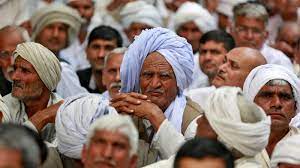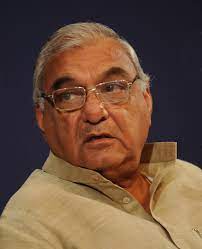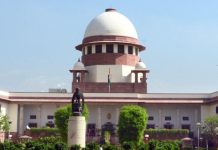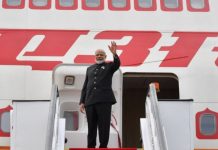The political permutations and combinations following the collapse of the ruling BJP-JJP alliance and the angst against BJP government among the Jats in state, have catapulted the community to the centre stage and jeopardized what was being predicted as an easy win for BJP, writes Aayush Goel

In the run-up to the Lok Sabha elections, a significant political shift in Haryana has yet again pivoted the elections around the prominent Jat community of the state. The shifting of leaders from one party to another, major being the return of former Union Minister Chaudhary Birender Singh along with his son, the incumbent MP from Hisar, Brijender Singh and wife Prem Lata, to the Congress after 10 years, the collapse of Jannayak Janta Party (JJP), speculations of its reunion with Indian National Lok Dal (INLD) and angst against BJP government amongst farmers, primarily Jats in state, has put community at the centre stage and jeopardised what was being predicted as an easy win for BJP.
Jat leaders have dominated Haryana politics since the formation of the state in 1966 even though the community accounts for only 28 percent of the state’s population. In the last 58 years, the state has been ruled by Jat chief ministers for 33 years. Bhagwat Dyal Sharma, Rao Birender Singh, Bhajan Lal, Manohar Lal Khattar, and current CM Nayab Singh Saini have been the members from the non-jat community, who have occupied the CM’s chair in the state so far. According to political analysts, though the community is focusing on forthcoming assembly elections influencing a minimum of 36 out of 90 assembly segments, but with changed equations now, they will be key deciding factors in at least four of the 10 parliamentary constituencies – Sirsa, Hisar, Rohtak, and Sonipat. Having virtually been out of power for 10 years the community is out to reclaim its supremacy in state.
Framers’ angst against BJP and JJP
In Haryana, farmers are primarily Jats who have been up against the BJP led centre government since farmers protest in 2021, and wrestler’s agitation thereafter. The sentiment seeped down and resulted in community’s antagonism towards the state’s BJP-JJP government, and flared up after the recent faceoff with farmers at Shambhu border in Ambala. The resentment is now showing up with farmers reportedly shooing away BJP and JJP leaders when they reach the villages for campaigning. Mohan Lal Badoli, BJP candidate from Sonipat parliamentary seat, went to campaign at Rohna village earlier this month, he was surrounded by hundreds of jeering and protesting farmers. The escalating situation forced Badoli to cut short his election speech and hurry away.
Like Badoli, BJP candidates Ranjit Chautala (Hisar), Arvind Sharma (sitting MP Rohtak), and Ashok Tanwar (Sirsa) also faced protests. 24 villages under the Dahiya Khap have boycotted BJP and warned candidates against trying to approach them. The farmers’ anger is also directed towards the BJP’s former ally, JJP, as well, as former deputy CM Dushyant Chautala was stopped from entering the Nara village in Hisar, a Jat stronghold. Chautala’s mother Naina Singh, an MLA from Badhra, says he is paying price for allying with the BJP though had no power to alter the situation.
According to Pagri Sambhal Jatta, Kisan Sangharsh Samiti, a farmers’ union and constituent of the larger umbrella body, Samyukta Kisan Morcha (SKM), these protests are part of the ‘Jawab Do, Hisab Lo (seek answers, hold them to account)’ campaign – a concerted effort to hold the ruling establishment accountable for its work over the past five years.
Challenge to tap jat votes for BJP
As per the voting pattern observed in Haryana, in 2019 Lok Sabha and Vidhan Sabha elections, 39.8 percent of the Jat population voted for the Congress in Lok Sabha polls while 42.4 percent voted for the BJP, and the remaining voted for the JJP, INLD, and others. This was credited to the Modi wave as the pattern changed in assembly elections which were held within the next few months. In the assembly elections, the JJP secured 12.7 percent of Jat votes while the Congress share was 38.7 per cent. The BJP received 33.7 percent of Jat votes. It was this pattern that was blamed for the BJP’s poor performance in the 2019 assembly elections, in which five of its six jat candidates lost .
As a result, the party was forced to make alliance with newly formed JJP which was carved out of INLD following a fall out between Chautala brothers, Abhay and Ajay. This alliance became a saviour and JJP’s scion Dushyant Chautala was made the deputy CM of state. All was well till this winning ‘couple’ split in March this year. The BJP now faces a formidable challenge to garner votes in the Jat belts and tap the community voters who are clearly cut up with the BJP. The split coupled with cold shouldering of prominent Jat leaders like former BJP chief OP Dhankar, Captain Abhimanyu, the exit of jat stalwart, former Union minister Chaudhary Birender Singh and his son Brijender Singh, and sole attention towards backward classes of have fuelled the growing mistrust in community against the BJP. Though the BJP has been trying to make inroads at strategic local levels, trying to connect with local jat leaders but it is not leading to any significant shift in the situation so far. The BJP, however, says the opposition is misleading the farmers and voters and they will vote for development.
“The protests are all orchestrated by the Congress workers and not local residents. People will see through their game and vote for development as they have seen where BJP has brought them in 10 years”, says former CM and now party candidate from Karnal Manohar Lal Khattar.
Congress gains an upper hand in community
The parting of the JJP from the alliance and rising dissent against BJP among the community may prove to be a reviver for the Congress, which has been ailing with infighting and fractionalisation so far. The five-and-a-half-year-old JJP has been in crisis since its coalition with the BJP in the state ended in March. The JJP has been rocked by a spate of high-profile resignations like general secretary Kamlesh Saini, Haryana unit chief Nishan Singh, Mamata Kataria, former JJP state women’s secretary, and MLA Jogi Ram Sihag. Majority of these leaders are speculated to join Congress. Though the party supremo, Ajay Chautala has expressed wish for reunion with estranged father and INLD supremo OP Chautala, but his brother says the party has no place for traitors. With the JJP, which caused a split in Jat votes during the 2019 elections, is virtually out of the picture and the INLD still struggling to survive, the Congress is gaining an upper hand.

The community still fondly remembers the 10-year long spell of the Congress government led by Bhupinder Singh Hooda who is credited for consolidating them as a loyal voter base for the party. Having prominent Jat leaders like Hooda and Randeep Surjewala, Congress has got another boost with Birender Singh returning to the party after 10 years. He had departed from the Congress in 2014 and served as a Cabinet minister in the Modi government.
Being the grandson of the eminent farmer leader, Sir Chhotu Ram, and known for his clean image, he is a major vote puller. Though things seem to be falling in place for the party to reclaim its traditional vote bank, fractionalisation poses a major challenge, especially in Lok Sabha elections. The three Jat leaders, Hooda, Birender Singh and Surjewala are not exactly on the same page and are striving to carve their own shares in the vote bank. The veterans, Birender Singh and Bhupinder Hooda, have expressed reluctance to contest Lok Sabha elections despite the high command’s wishes and recommended the names of their sons from Hisar and Rohtak, respectively. While Birender’s son, former IAS Brijender Singh is a sitting MP from Hisar and had recently quit BJP, Hooda’s son Deepender is Rajya Sabha MP for Congress from Rohtak. INLD too is gripped with factionalism. But will this result in a good turn for BJP remains a big question.












